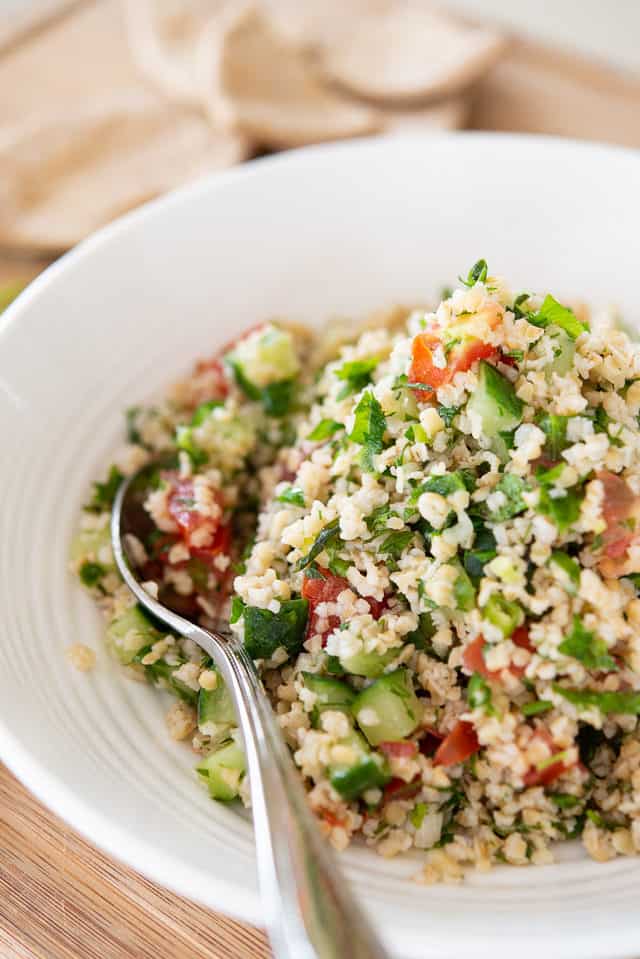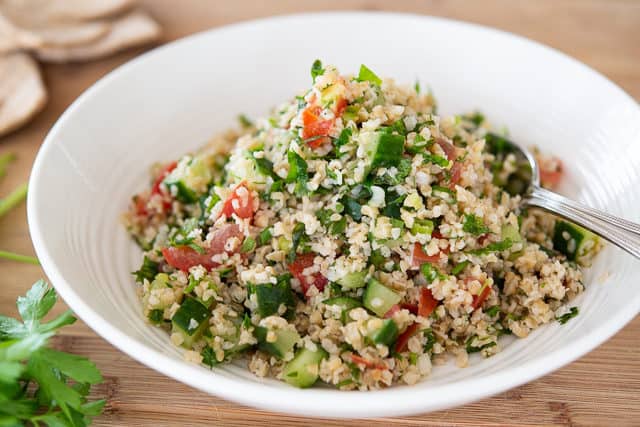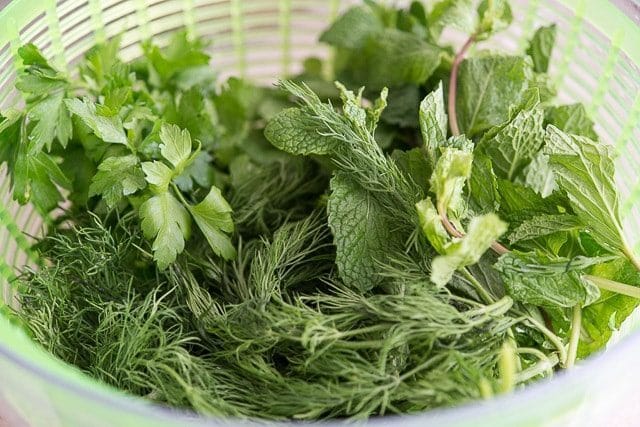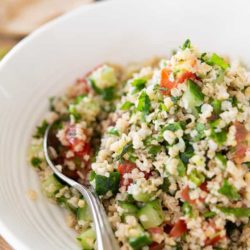Tabbouleh
This fresh Tabbouleh is an easy bulgur salad recipe full of fresh cucumber, tomatoes, and lots of chopped herbs. It’s great on its own, as a healthy side dish, or in a pita with Grilled Chicken Breast! Make it even better with a few Stuffed Grape Leaves, Marinated Olives, and a side of Baba Ganoush.

Anytime I overindulge after a vacation or holiday, I find myself craving lots of fresh salads and fruit to reset my body a bit. And this tabbouleh is one of my favorite healthy recipes to turn to!
If you’re not familiar with tabbouleh, it’s a fresh vegetarian middle Eastern salad made with bulgur, lots of fresh herbs, fresh tomatoes and cucumber, extra virgin olive oil, and fresh lemon juice.
It’s one of the many staples you often see at Middle Eastern restaurants, and I love pairing it with homemade hummus, pita, tzatziki, and chicken breast for a full meal.
Variations in Traditional Tabbouleh
There are different variations in Tabbouleh as more of a parsley salad versus a bulgur salad.
It seems that traditionally, Tabbouleh is a greener salad most heavy on the fresh parsley, but as it has become more popular, it is often made with a higher ratio of bulgur. This is personally what I prefer. There’s still plenty of freshness bursting through every bite, but it has a heartier feel to it.
Play with the ratios as you see fit, and know that you can adjust it at the end.
What’s Bulgur?
Bulgur is the main ingredient in tabbouleh, and it’s a cracked wheat product that looks like this:

You will likely find this whole grain in the bulk section of your grocery store (I get it at Whole Foods). If you have a choice in the matter, buy a more coarse bulgur, and make sure to avoid buying an extra fine bulgur, which won’t have the right texture.
Once you’re ready to cook, the process is incredibly easy. All you need to do is pour some boiling water on top and let it sit. So even if you had no stove, you could still make this by using an electric tea kettle to boil the water, or a microwave.
Because bulgur is a wheat product, please note this is not gluten-free. However, I’ve tried tabbouleh using Quinoa and also Cauliflower Rice, and both are wonderful gluten-free alternatives that are also very healthy!
Tips for Best Results
Use the freshest ingredients – It’s the herbs and vegetables that really make tabbouleh sing, so you’ll want to use the freshest ingredients possible. Herbs and produce lose their flavor the longer they sit in the fridge.
Make the bulgur first – Since the bulgur will take an hour to soften, it’s best to start that first, then wash, chop, and prep all the fresh ingredients. No need for mise en place here.
Dry the herbs thoroughly – Make sure after washing the herbs, that you dry them thoroughly. A lot of people make this mistake with salad, where they don’t dry the greens well enough and then the excess water ends up diluting the flavor of the dressing. Dry everything well.

Step by Step Overview
To make the tabbouleh, start by pouring boiling water on top of the bulgur in a large bowl. It’s very important you’re using boiling hot water here, and not cold water, as the heat will gently cook the cracked wheat.
Quickly add some salt, and let it sit for an hour, covered.

During that time, the tabbouleh will absorb all the liquid, and you should end up with a soft, tender texture that almost looks like cooked couscous:

Now it’s time to jazz the bulgur up.
Parsley and fresh mint leaves are traditional for tabbouleh, but I also like fresh dill in mine. I think flat-leaf parsley is a little better than curly parsley, but either will work.
Wash, then dry all the herbs thoroughly.

I like to use a salad spinner, then dry further with paper towel. It is essential that you don’t water down your recipe with excess water.
Chop the herbs finely using a sharp knife, then add them to the bowl along with chopped ripe tomatoes, chopped English cucumbers, and scallions (aka green onions or spring onion).

Not everyone uses cucumber for Tabbouleh, but I’ve had it this way at many restaurants and think its flavor profile and crunch fit in perfectly.
Also, for best results, cut everything by hand. A food processor will not give you even results.
Next add a high-quality, extra virgin olive oil:

Olive Oil Recommendations
For the best flavor, use a really good quality and aromatic extra virgin olive oil here. A few of my favorites are California Olive Ranch, Trader Joe’s 100% Greek Kalamata EVOO, and Lucini Extra Virgin First Cold Press.
Next add freshly squeezed lemon juice, for brightness and acidity:

Give it a good stir, then adjust the seasoning to taste with salt and black pepper.

How to Serve It
Tabbouleh is definitely best when enjoyed fresh. I find that it’s not even something you need to allow to sit and meld for an hour before serving, and it’s best at room temperature so the bulgur doesn’t get overly firm.
Serve this on the side of main dish meats like Roasted Pork Tenderloin, Grilled Chicken Breast, and even Grilled Salmon. Or stuff into pita bread pockets with Baba Ganoush and Black Bean Hummus.
Broccoli Salad, Coleslaw, and Greek Zucchini Salad are some of my other favorite fridge-friendly salads to make when I’m craving something healthy. Enjoy!
Recipe Tips and FAQ
Keep in an airtight container in the fridge for up to 3 days. You may consider storing it in a fine-mesh strainer over a bowl, covered with plastic wrap, to allow any excess moisture to drain off.
Not recommended. The raw cucumber, tomatoes, and herbs don’t hold up well.
This is not a dish you want to reheat, because of the cucumbers and fresh herbs. Enjoy it cold from the fridge, or set it out on the counter for 30-60 minutes before serving in order to allow it to warm up slightly.
Yes, though I wouldn’t make it more than one day ahead, because the freshness deteriorates pretty quickly. However, if you want to make just the bulgur ahead of time, that can be done 2-3 days in advance and held in the fridge.
Did you enjoy the recipe? Please leave a 5-star rating in the recipe card below and/or a review in the comments section further down the page. Or, follow me on Facebook, Instagram or Pinterest!

Tabbouleh
Ingredients
- 1 cup bulgur wheat* (dry)
- 1.5 cups boiling water
- 1 tsp salt
- 1/2 cup fresh chopped mint
- 1/2 cup fresh chopped parsley
- 1/2 cup fresh chopped dill
- 2 large tomatoes seeded and chopped (about 2 cups)
- 1 English cucumber seeded and chopped
- 1 bunch scallions sliced (white and green parts)
- 1/4 cup extra virgin olive oil
- 2 tbsp freshly squeezed lemon juice
- ground black pepper to taste
Instructions
- Place the bulgur in a bowl, then pour over the boiling water. Stir in the salt, then let the bowl sit, covered, for 1 hour, until the liquid has been absorbed.
- Add the chopped herbs, tomatoes, cucumber, scallions, oil, and lemon juice, and give it all a good stir. Season to taste with salt and pepper, then serve.
Notes
Nutrition
Nutrition is estimated using a food database and is only intended to be used as a guideline for informational purposes.
Post updated in March 2019. Originally published in September 2015.

4 Comments on “Tabbouleh”
This recipe looks great! Thank you so much for sharing. Cannot wait to make this at home.
Made this with hummus, grilled chicken, and tzatziki for a mediterranean feast. This was perfect!
Yummy! This looks so fresh and healthy. Absolutely love this.
Thank you – nice.